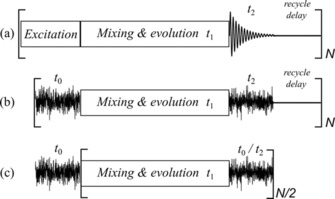Figure 1.

a) Generalized timing scheme of a pulse‐excited 2 D NMR experiment. t 2 denotes the acquisition block recording the FID. The period t 1 represents the indirectly detected dimension. Coherence transfer occurs during excitation and mixing periods. b) Acquisition scheme of a spin‐noise‐detected 2 D NMR experiment. t 0 and t 2 both denote acquisition blocks, where the so‐called noise blocks are recorded. Correlated together, they correspond to the directly detected dimension t 2 of scheme (a). c) Efficient fast acquisition scheme for spin‐noise‐detected 2 D NMR experiments with DBU halves the number of noise block recordings. The mixing and evolution periods and the acquisition block labelled t 0/t 2 are repeated as required to obtain sufficient signal‐to‐noise ratio. Recycle delays are completely omitted with this scheme, which further reduces the total experimental time.
